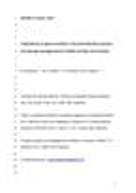Please use this identifier to cite or link to this item:
https://repositorio.uca.edu.ar/handle/123456789/5487| Título: | Implications of glass transition in the devitrification process and storage management of vitrified oocytes and embryos | Autor: | Sansiñena, Marina Julia Zaritzky, Noemí Taminelli, Guillermo Santos, María Victoria |
Otros colaboradores: | Universidad Católica Argentina. Facultad de Ciencias Agrarias Universidad Nacional de La Plata. Facultad de Ingeniería. Centro de Investigación y Desarrollo en Criotecnología de Alimentos CONICET |
Palabras clave: | VITRIFICACION; EMBRIONES; NITROGENO LIQUIDO | Fecha de publicación: | 2014 | Cita: | Sansinena, M., Santos, M. V., Taminelli, G. y N. Zaritky. 2014. Implications of glass transition in the devitrification process and storage management of vitrified oocytes and embroyos [en línea]. Postprint del artículo publicado en Theriogenology: http//dx.doi.org/10.1016/j.theriogenology.2014.04.003 Disponible en: https://repositorio.uca.edu.ar/handle/123456789/5487 | Resumen: | Abstract: Devitrification, the process of crystallization of a formerly crystal-free, amorphous glass state, can lead to damage during the warming of cells. The objective of this study was to determine the glass transition temperature of a cryopreservation solution typically used in the vitrification, storage and warming of mammalian oocytes and embryos using Differential Scanning Calorimetry. A numerical model of the heat transfer process to analyze warming and devitrification thresholds for a vitrification carrier (open-pulled straw, OPS) was conducted and the implications on specimen storage in nitrogen vapor phase were determined. The time required for initiation of devitrification was determined by mathematical modeling and compared with temperatures in the vapor phase of liquid nitrogen cryogenic dewars. Results indicated that the glass transition ranged from -126 to -121ºC and devitrification was initiated at -109ºC. Interestingly, samples entered rubbery state at -121ºC and therefore could potentially initiate devitrification above this value, with the consequent damaging effects to cell survival. Devitrification itimes were mathematically modeled considering an initial temperature of material immersed in liquid nitrogen (-196ºC) and two arbitrarily selected temperatures (-50 and -70ºC) to which a sample could be exposed at the neck of dewar. The mathematical model indicated samples could reach glass transition temperatures and undergo devitrification in 30 seconds. Results of the present study indicate storage of vitrified oocytes and embryos in the liquid nitrogen vapor phase (as opposed to completely immersed in liquid nitrogen) poses the potential risk of devitrification. Due to the reduced time handling period before samples reach critical rubbery and devitrification values, caution should be exercised when handling samples in vapor phase | URI: | https://repositorio.uca.edu.ar/handle/123456789/5487 | Disciplina: | INGENIERIA EN ALIMENTOS | Derechos: | Acceso Abierto | Fuente: | Posprint del artículo publicado en Theriogenology, 2014 |
| Appears in Collections: | Artículos |
Files in This Item:
| File | Description | Size | Format | |
|---|---|---|---|---|
| implications-glass-devitrification.pdf | 409,59 kB | Adobe PDF |  View/Open |
Page view(s)
121
checked on Apr 30, 2024
Download(s)
201
checked on Apr 30, 2024
Google ScholarTM
Check
This item is licensed under a Creative Commons License

